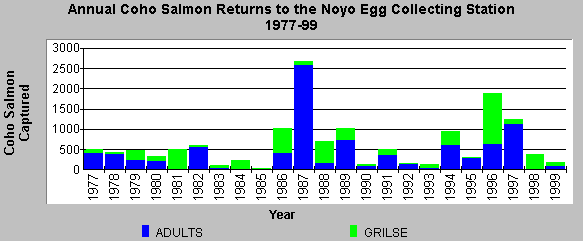Bibliography Background About KRIS
Hypothesis #6 Excluding grilse from brood stock at the Noyo River Egg Collecting Station is decreasing genetic diversity.
Support for the hypothesis from the literature
The Noyo River Egg Collecting Station Annual Reports (Sanders, 1978,1980,1982,1983; Grass, 1981,1983, 1988,1989-1993; Poe,1984,1987) document that small adult male coho or grilse are not spawned but rather sacrificed. Grilse return to the ocean after only one year in the ocean as opposed to two years, which is normal for coho salmon. Grilse comprise a large component of returns in some years. The National Marine Fisheries Service (Hard et al., 1992) indicate that small scale rearing facilities and large hatcheries should include all age classes of returning adult Pacific salmon when spawning hatchery fish. Because of low levels of returns in some years to the Noyo River Egg Collecting Station, genetic diversity of coho salmon broodstock is a concern. Many northern California coho populations have strong and weak year classes as a result of lack of mixing between brood years (Wendy Jones, personal communication). Mixing gene in gene resources from grilse would help to mix populations between years which would help avoid genetic loss. Therefore, not spawning coho does is decreasing genetic diversity of the Noyo Egg Collecting Station.
Data from the Noyo Basin
See Topic: Fish: Noyo Hatchery Coho Salmon Adult/Grilse Returns 1977-1999 for complete metadata and context.

The chart above shows a highly variable return of adult and grilse coho salmon to the Noyo Egg Taking Facility from 1977 to 1999. Grilse made up a large component of the run in many years. The grilse are not used for broodstock nor allowed to spawn naturally in the stream.
Alternative Hypothesis
Excluding grilse from brood stock at the Noyo River Egg Collecting Station has had no effect on genetic diversity of coho broodstock.
Hatchery personnel or California Department of Fish and Game management personnel might provide support for this argument. Testing this alternative hypothesis would be the same as that for the primary hypothesis advanced.
Monitoring Genetics of Noyo Coho to Support or Refute the Hypothesis
Genetic tests of Noyo Egg Collecting Station brood fish and other, non-hatchery fish in the Noyo Basin trapped in downstream migrant traps would allow comparison of wild and hatchery coho genetic diversity. Family size of both hatchery and wild coho should also be measured to determine genetic diversity (Simon et al., 1986).
References
Grass, A. 1981,1983,1988,1989-1993. Annual Report Noyo River Egg Collecting Station (various years). California Department of Fish and Game, Region 3, Inland Fisheries.
Hard, J.J., R.P. Jones, Jr., M.R. Delarm, and R.S. Waples, 1992. Pacific salmon and artificial propagation under the Endangered Species Act. US Department of Commerce, National Marine Fisheries Service, Technical Memorandum NMFS-NWFSC-2, S
Poe, S.D. 1984,1987. Annual Report Noyo River Egg Collecting Station (various years). California Department of Fish and Game, Region 3, Inland Fisheries.
Riggs, L., 1990, Principles for genetic conservation and production quality. Northwest Power Planning Council, Contract No. C90005, Portland, OR.
Sanders, S.W. 1978,1980,1982,1983. Annual Report Noyo River Egg Collecting Station (various years). California Department of Fish and Game, Region 3, Inland Fisheries.
Simon, R.C., J.D. McIntyre, and H. Hemminigson. 1986. Family size and effective population size in a hatchery coho salmon population. Canadian Journal of Fisheries and Aquatic Sciences 43: 24-34